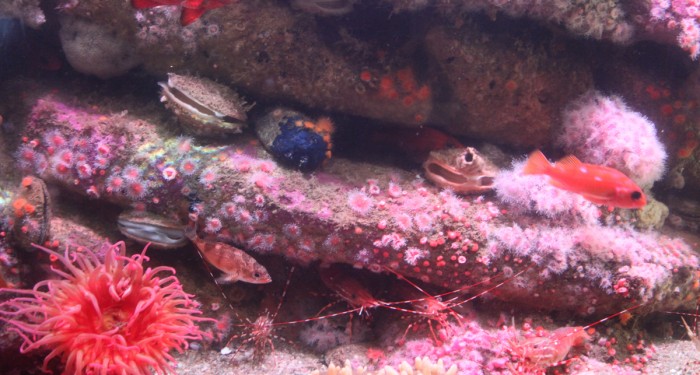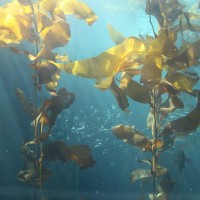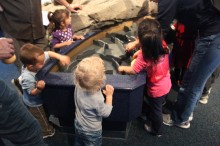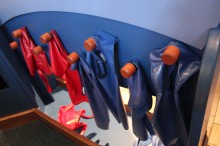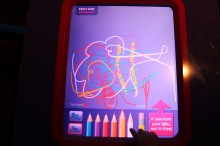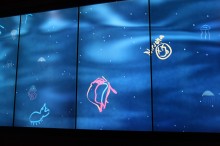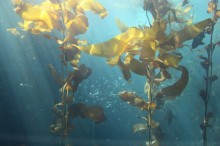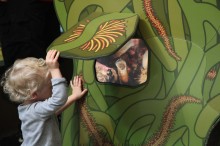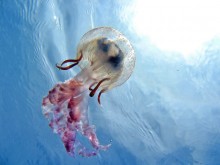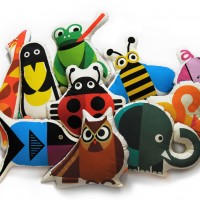With two floors of amazing and interactive exhibits, The Monterey Aquarium is a masterpiece of all things magnificently marine.
Set over two floors, there are four major hubs at this aquarium. At one end of the building is The Ocean’s Edge: upstairs, there are penguins, touch pools and a splash zone, best for toddlers through to ages six or seven.
Downstairs is where you’ll find the Kelp Forest, the octopus tanks, Monterey Bay Habitats, Aviary, touch pools (for all ages) and not-to-be-missed ‘ocean wave tunnel’ where you can stand in awe as the waves crash over and around you
At the other end of the building, across The Bridge – which comes complete with a full-scale whale floating above your head – is The Open Sea, where jellies, puffins, a Flippers, Flukes & Fun zone, The Open Sea tank and an amazing full circular swim tank (where fish rotate above and around you) are all upstairs; and The Jellies Experience (an incredibly magical exhibit with some very exciting interactive activities – just watch our video, below), Vanishing Wildlife and The Secret Lives of Seahorses downstairs.
Each of these four hubs deserves at least an hour or two to explore, and in each, you will find interactive exhibits where children of all ages will want to stop and play. There is also a host of spaces and places where you will all simply want to take a moment to sit and watch and ponder the life that is mostly invisible to us land-dwellers.
With a toddler who is a true fan of all things under the sea (including those nautical stalwarts The Octonauts), and having visited our fair share of aquariums around the world, we nonetheless could have done with a serious warning that this is not only a place to visit, but that we needed to dedicate the better part of a day to exploring. Sure, we could have whipped in and around the exhibits and out again, but it was so awe-inspiring that none of us had any desire to rush the experience. It seemed that every single activity and event was a hit, from the Splash Zone where toy creatures can be washed around by the tide, to the Jellies digital drawing theatre and the Kelp Forest diver’s talk. There are also highlight events throughout the day that are well worth the time to stop by and see – from the Sea Otter Feeding to the Jellies Tour or the Mysteries of the Deep talk.
Highlights for toddlers
• The upstairs Touch Pools in The Ocean’s Edge where the pools have been designed at toddler/preschooler age height to allow them complete run of the pools. Make use of the adorable waterproof aprons that hang on hooks here to help ensure your child won’t come away saturated.
Highlights for school-ages
• The Kelp Forest talk with a diver reporting from inside the tank and feeding the various fish who live there.
Highlights for tweens
• Anything and everything – from The Vanishing Wildlife stories on the ground floor on The Open Sea side, to the Mission To The Deep hub on the ground floor level at the entrance to The Ocean’s Edge. They will also love the Kelp Forest Talk and The Jellies Experience where there are a host of additional interactive activities for this age group.
All ages, don’t leave without…
• Experiencing The Wave Tunnel (the ground floor on The Ocean’s Edge side of the building, almost hidden beside the touch pools and aviary) where you can have the ocean waves crash over your head and wash away around you. All the joy of being tumbled in the surf without the sand getting in your eyes.
• Visiting The Jellies Experience on the ground floor in The Open Sea – where you will all be mesmerised by these spineless, brainless yet dreamy creatures – and where you must stop to draw your very own jellyfish on the interactive drawing board which turns your creation into a floating apparition on a huge screen, and allows you to turn it into a file that gets sent to your personal email address for printing out at home. Magical stuff!
• Seeing the sea otters at play.
Why go? One of the world’s most outstanding aquariums, you may go planning to spend an hour or two, but will find that you wish you had planned for the whole day… why, because just when you think you have seen everything beautiful in the marine world, you will discover another wing of this amazing temple to all things beneath the sea.
Who is it best for? There is plenty here to inspire children of all ages with a brilliant range of interactive experiences; so toddler to tween.
Top Tip… This is a pretty expensive attraction on its own, so – if you are also visiting San Francisco – be sure to buy a San Francisco City Pass, which costs US$84 for adults and covers this attraction (which alone costs US$35) as well as the San Francisco cable cars, The California Academy of Sciences, the Exploratorium as well as one of two cruise boat experiences.
Our favourite bit… Almost impossible to choose, but it is probably a tie breaker between the jellyfish wing and the ocean wave tunnel.
Don’t Go… Expecting to spend just an hour or two… this is better as a long half day (4 to 5 hours).
Before You Go… Download the fab Monterey Bay Aquarium Planning App.
While You’re In The Area… Head down the 17-Mile Drive from Monterey to the stunning seaside town of Carmel-by-the-Sea. This is a gorgeous little town, and 17-Mile Drive is one of the most famous scenic drives in the world.
Additional Fun
• Summer sleepovers, where you check in at 6pm before the doors close at 8pm, and you then get to have a late-night movie before falling asleep in front of your favourite exhibit cost $95 per person and are available for families with children 5 years and over. They only run two nights a year, so book well in advance if this is something you would like to do. For more information, take a look at the full instructions on what sleepovers entail.
• Print out the Aquarium’s brilliantly designed activity sheets and your child will soon be an authority on the creatures of the sea.
• Get to know the creatures you have met at the Aquarium better with these authoritative animal guides.
Armchair Traveller
For inspiration, you can watch the Monterey Bay Aquarium live cams right now – take a look at the Kelp Cam, the Sea Otters Cam, or – possibly our favourite – the Open Sea Cam.



